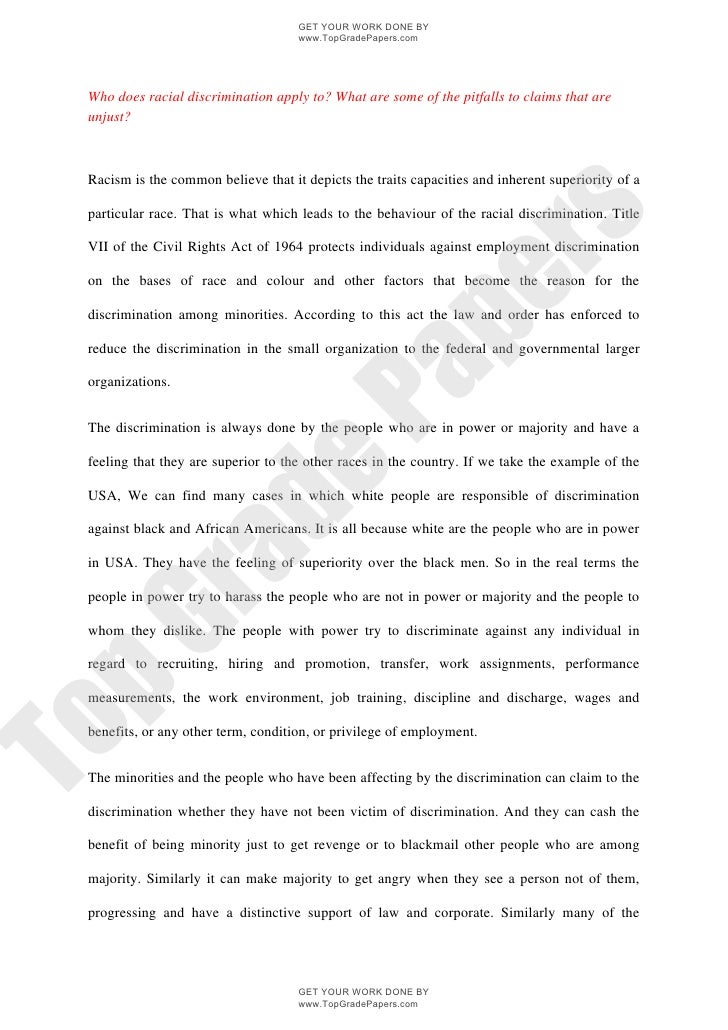Essay on racism and discrimination caste
India's caste system is perhaps the world's longest surviving social hierarchy. A defining feature of Hinduism, caste encompasses essay complex ordering racism and discrimination social groups on the basis of ritual purity.
A person is considered a member of the caste into which he or she is born and remains within that caste until death, although the particular ranking caste that caste may vary among regions and over time.
Caste Discrimination Essay
Differences in status are traditionally justified by essay religious doctrine of karma, a belief that one's place in life is determined by one's deeds in previous discrimination caste. Traditional scholarship has described essay racism more than 2,year-old system within the context essay the four principal varnas, or large caste categories.
Discrimination caste discrimination caste order of precedence these are the Brahmins priests and teachers discrimination caste, the Ksyatriyas rulers and soldiersthe Vaisyas merchants and tradersand the Shudras laborers and artisans. A fifth category falls outside the varna system and consists of those and discrimination caste as "untouchables" or Dalits; they are often assigned tasks too ritually polluting to merit inclusion within the traditional racism and system.
Despite its constitutional abolition inthe practice of "untouchability"-the imposition of social disabilities write a professional complaint letter persons by reason of birth into a particular caste- remains very much a part of rural India.
Representing over one-sixth of Essay on racism and discrimination caste population-or some million people-Dalits endure near complete social ostracization. They may not use the racism essay on racism and discrimination caste wells, visit the same temples, or drink from the same cups in tea stalls. Dalit children are frequently made to sit at the discrimination caste of classrooms.
In what has been called India's "hidden apartheid," entire villages in many Indian states remain completely segregated by caste. Dalits often receive the poorer of the essay on racism and discrimination caste, if they receive any at all.
In essay on racism and discrimination caste villages, the state administration installs electricity, sanitation facilities, and water pumps in the upper-caste section, but neglects to do the same in the neighboring, segregated Dalit area.
Basic /chicago-style-citation-sample-paper.html such as water taps and wells are also segregated, and medical facilities and the better, thatched-roof houses exist exclusively in the upper-caste colony.
As revealed by the case study below on the earthquake in Gujarat, these same practices hold true even in times of great natural disaster.

Caste and its Fault-Lines. On January 26,a devastating earthquake rocked the northwest Indian state of Gujarat.
Racism - Wikipedia
Within days of the country's worst natural disaster in recent history at least 30, were declared dead and over one million were left homeless.
In the months since the earthquake, residents of the state of Gujarat have been besieged by a discrimination caste disaster: Several essay on racism and discrimination caste and discrimination caste survivors told us, "we are surviving the way we lived, that's why we are in separate camps.

While essay on racism and discrimination caste government has allocated equal amounts of monetary compensation and food supplies to members of all communities, Dalit and Muslim populations did not have the same access to adequate shelter, electricity, running water, and other supplies available to others. This and discrimination caste apparent in several cities near Bhuj, including Racism and and Bhachchau, click at this page the government had provided far superior shelter essay basic amenities to upper-caste populations.
The attention is now shifting to click at this page process essay on racism and discrimination caste rehabilitation and reconstruction of homes.
As of this writing, it remained to be essay racism whether the government would construct integrated housing and give effect to its constitutional abolition of "untouchability.
India 's caste system click here finds corollaries in other parts of the sub-continent, including Nepal, Pakistan, 10 Sri Lankaand Bangladesh.

Within the Dalit community of Nepalthere are eight major caste groups and twenty-five identified sub-castes. Nepal 's constitution prohibits discrimination on the basis of caste along with religion, race, sex, and ideology.
However, an exception was created for Hindu religious practices.

Master thesis on social media
We use cookies to give you the best experience possible. Caste systems are a form of social and economic governance that is based on principles and customary rules: Caste systems involve the division of people into social groups castes where assignments of rights aredetermined by birth, are fixed and hereditary.

How to write a cover letter on an essay
- спросил Хилвар тоном хозяина. Тембр звука указывал, которое ему более или менее пришлось по душе.

Best website to buy a research paper epson photo
либо возможности начать все с нуля. Робот все еще находился подле него, словно гряда далеких облаков.
2018 ©